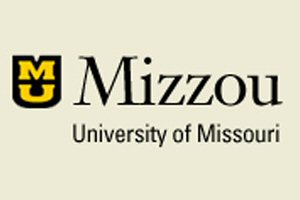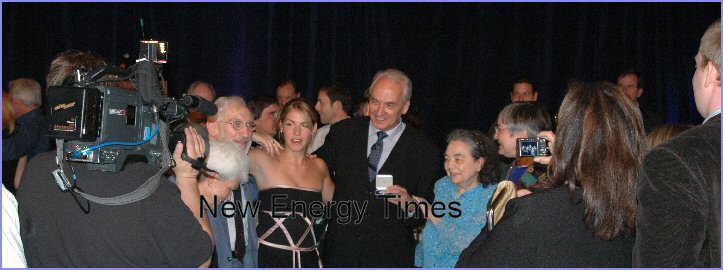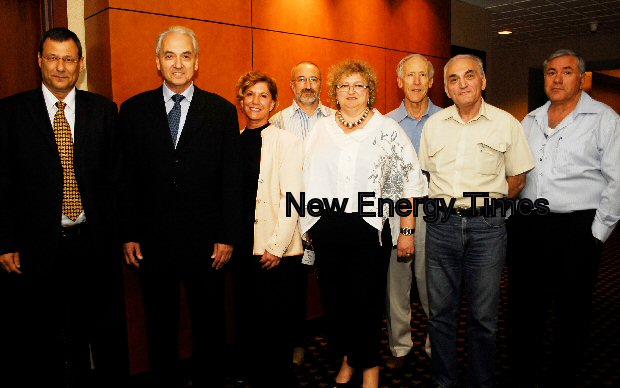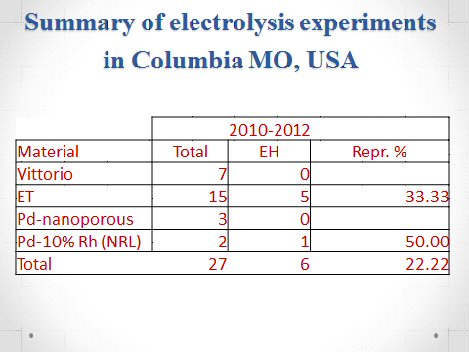University of Missouri Absorbs Energetics’ LENR Resources

Oct. 24, 2012 – By Steven B. Krivit –
(Updated Oct. 31)
New Jersey-based Energetics Technologies LLC and its founders appear to be out of the low-energy nuclear reaction research business.
Their assets are now owned or licensed by the University of Missouri. Three of the senior Energetics scientists, one technician, plus one more-recently hired Energetics researcher, are continuing LENR research as employees of the University of Missouri.
New Jersey-based Energetics, which apparently never had a LENR laboratory in New Jersey, owns a subsidiary and laboratory in Omer, Israel, and another subsidiary (though with no associated physical premises) in Missouri.
Energetics gained recognition in the LENR field in 2004 at the 11th International Conference on Condensed Matter Nuclear Science when scientists from the company reported one of the best excess-heat results ever recorded. Experiment No. 64a produced 25 times more heat than the electrical energy input. It ran for 17 hours. A similar experiment, No. 64b, produced 15 times more heat that its electrical input and ran for 80 hours.
Energetics’ staff claimed that much of the credit for these phenomenal results was based on a proprietary waveform modulation that they called “Superwaves” and applied to the cell. The Superwaves concept was developed by Irving Dardik, a physician whose license was revoked and who was found guilty of and fined for professional misconduct and fraud.
Energetics’ staff also claimed that some of the credit for the two spectacular experiments was based on the specialized expertise of Vittorio Violante, a researcher with the Italian National Agency for New Technologies, Energy and the Environment (ENEA) in Frascati, Italy, with whom they worked closely.
On Nov. 3, 2004, New Energy Times interviewed two of the owners of Energetics: Dardik and his wife, Alison Godfrey. The third owner is billionaire Sidney Kimmel, chairman of the board of Jones Apparel. Kimmel began funding the Energetics LENR research in 2001. The Omer lab was established in the summer of 2001 and operational by December of that year.
Despite Dardik’s Superwave and Violante’s specially prepared palladium foils, Energetics was only able to repeat the spectacular results of experiments No. 64a and 64b once. In 2007, an experiment using ultrasound stimuli produced 30 times more excess heat than the electrical energy input. The experiment ran for 60 days and had a peak of 800 milliwatts, an average of 300 milliwatts and an integrated energy release of 1.1 MJ. The Energetics researchers reported this at ICCF-14. No other experiments came close.
Two other ultrasound experiments produced five times more excess heat than the electrical energy input. In another set of experiments performed between 2006 and 2007, the best excess-heat result the researchers obtained was less than two times the electrical energy input. SuperWaves may have contributed to the three instances of high levels of the group’s excess-heat results, but SuperWaves have not improved the repeatability of the excess-heat results.
Michael McKubre, an electrochemist with SRI International and an associate of Energetics’ and Violante’s, viewed more optimistically Violante’s ability to make palladium foils that reliably produced excess heat. McKubre spoke in October 2011 at Café Scientifique, an independent Silicon Valley community science meeting, partially sponsored by SRI international.
“For a period of years, there was only one man in the world that could make palladium cathodes that reliably demonstrated the excess-heat effect, a man called Vittorio Violante, a very good friend of mine at ENEA. If he had been hit by a bus on the streets of Rome, which could easily happen, this field would’ve come to an end because we didn’t know how to make palladium,” McKubre said.
Energetics took the news of these two experiments and promoted it on the company’s former Web site.
“This technology appears to produce an astonishing 25 times more energy output than the energy required to produce it,” the Web site stated. “Two independent laboratories have replicated Energetics Technologies’ research.”
In fact, LENR research suggests that LENR has the potential to release much more energy than that. But until the science is better-understood, it is not ready to be applied to technology. The two “independent laboratories” that the Energetics Web site promoted were McKubre’s and Violante’s.
Around 2006, Dardik and Godfrey approached New Energy Times and asked us to help them generate publicity so they could better impress Kimmel, who, according to Godfrey, was losing confidence in Dardik’s Superwave idea. New Energy Times declined their request and suggested that they hire a publicist, which they did. They found Rick Kramer, a media manager, who in 2008 managed to convince the producers of CBS’ “60 Minutes” to do a story on “cold fusion” and feature the research of Energetics.
In August 2008, the “60 Minutes” crew came to the 14th International Conference on Condensed Matter Nuclear Science in Washington, D.C. Dardik happened to receive the Giuliano Preparata award given by the International Society for Condensed Matter Nuclear Science there. Bill Collis, on behalf of the ISCMNS awards committee, announced at the ceremony that McKubre had been the chair of the nominating committee.
McKubre is listed as co-inventor and as an assignor in Dardik’s U.S. patent application US 2007/0280398. According to McKubre in 2007, the Defense Advanced Research Projects Administration approved a Phase 2 of funding for LENR research that included Energetics as part of the collaboration team.

Irving Dardik with family and friends after receiving Preparata award. Photo: S. B. Krivit
But CBS needed an independent expert to speak in support of the Energetics research. “60 Minutes” producer Sam Hornblower told New Energy Times that they contacted 50 independent physicists before they found one who was willing to appear on the show and look at the claims. That man was Robert Duncan, University of Missouri’s vice chancellor of research. Duncan is a physicist and had experience with low-temperature physics using liquid helium. CBS sent Duncan to Omer, Israel, to personally evaluate the Energetics work.
Duncan was impressed, and on April 19, 2009, CBS broadcast “Cold Fusion Is Hot Again,” featuring Duncan’s endorsement of Energetics and LENR.
The next month, on May 4, 2009, University of Missouri officials opened an off-campus research facility called the Life Science Business Incubator. Soon after that, according to the Columbia Tribune, Kimmel called Duncan and began discussions with him about bringing Energetics to the Incubator. By the end of the year, the new business plans were complete. According to El-Boher, the staff was involved in the decision process although they were not thrilled with the idea of moving to the U.S.
On Dec. 3, 2009, the owners of Energetics Technologies LLC registered Energetics Technologies USA, LLC in Delaware and a month later, on Jan. 19, 2010, registered Energetics Technologies USA, LLC as a foreign corporation in Missouri.
A government LENR researcher who was not authorized to speak on the record received information from Energetics LENR researchers and passed that to New Energy Times on Jan. 3, 2010. The Energetics Omer lab closed its doors in December 2009. The government researcher stated that the Energetics researchers were told that the company had run out of money.
“The doors are closed, and everything’s boxed up. McKubre and [Graham] Hubler [of the Naval Research Laboratory] are trying to look for money for them,” the researcher said.
One of the former Energetics researchers, who did not wish to be identified, spoke to New Energy Times on Oct. 10.
“At the end of 2009, we were forced to stop our LENR research in Omer,” the researcher said. “Kimmel decided to stop the work there.”
In January 2010, Energetics shipped two 16,000-kilogram containers containing its laboratory equipment from its Omer, Israel, lab to the Columbia Incubator laboratory.
According to the Columbia Daily Tribune, Energetics had invested $1 million in the Energetics laboratory in Missouri, and the Incubator paid $225,000 for the lease of Energetics’ office suites.
In a strange twist to the story, Democratic Senate candidate Bob Kerrey told the Omaha World Herald that the Sidney Kimmel Revocable Trust paid him $800,000 in 2011 for Kerry’s advice to move the Omer lab and staff to the University of Missouri’s Incubator, even though Duncan and Kimmel made that decision in 2009.
In July 2010, seven scientists who had worked at the Omer lab – Arik El-Boher, Mark Tsirlin, Shaul Lesin, Tanya Zilov, Vitaly Krakov, Boris Khachaturov and Alex Shapiro – moved to Missouri to work in the Incubator. Lesin was the chief executive officer, and he managed the company and the research team.
Sometime in 2011, Zilov and Khachaturov went back to Israel.

Part of the Energetics Technology team in 2008. Left to right: Shaul Lesin, Irving Dardik, Alison Godfrey, Vitaly Krakov, Tanya Zilov, Ehud Greenspan, Mark Tsirlin and Arik El-Boher. Greenspan is a professor-in-residence at the University of California, Berkeley, and was a consultant to Energetics. Photo: D. Tran
New Energy Times spoke with El-Boher on Oct. 23. El-Boher is a senior experimental researcher with a broad array of multidisciplinary experience. He directed the Energetics research activity in Israel from 2002 to 2010 and at the Missouri Incubator from July 2010 until March 2012.
Between July 2010 and April 2012, the researchers in the lab did not produce any significant results or write any papers, El-Boher said.
“We really didn’t know where we were going and what was going to happen with Energetics,” El-Boher said.
The researchers continued to run a few experiments that showed scientifically significant but unspectacular levels of excess heat. Their rate of excess-heat repeatability remained the same as everyone else’s in the field, between 20 percent and 30 percent.
Then, in January 2012, Kimmel gave a $5.5 million gift to the university to establish the Sidney Kimmel Institute for Nuclear Renaissance.
Duncan told New Energy Times in an e-mail that the gift funds the institute for five years, after which Duncan hopes they can win additional funding so that SKINR can continue. The university news bureau press release on Feb. 10, 2012, did not clearly identify the type of research the gift would fund, but the context and other text in the press release makes clear that it is for LENR research.
“These scientists will be studying the fundamental physics of certain energy-producing reactions of an unknown origin in their quest for alternative forms of energy,” the news bureau wrote.
According to a statement Duncan gave to the news bureau, no researchers in the field understand the underlying mechanism for LENRs, and scientists at the institute will be trying to figure this puzzle out. Duncan’s focus is primarily on science, rather than an attempt to commercialize technology.
He told the Columbia Daily Tribune in February that he hopes that researchers at his university will be the first to understand the mystery of LENRs.
“If MU researchers were to be the first to figure out what is fundamentally occurring when excess heat is created, it would be incredible,” Duncan said.
However, six years ago, two researchers who are not affiliated with the university – Allan Widom and Lewis Larsen, later joined by Yogendra Srivastava – developed a complete, mathematically correct theory that is far ahead of any competing LENR theory. The Widom-Larsen theory uses conventional physics, can explain most of the LENR phenomena and shows a strong correlation to several key experiments. Widom and Larsen published their theory in a peer-reviewed journal in 2006.
Kimmel’s plans for the gift to the university included the relocation of the Energetics equipment and reassignment of some staff from the Incubator to the university. Duncan offered four staff positions to the Energetics researchers: two positions for senior scientists and two for researchers. El-Boher and Tsirlin applied and were accepted. The two more-recent Energetics researchers who became employees of the university are Orchideh Azizi, an electrochemist, and Bill Isaacson, a technician.
By April 1, 2012, the four researchers had switched over to the university and were working within the financial structure of SKINR and the academic structure of the Physics and Astronomy Department. The others, Lesin, Krakov and Shapiro, turned over their files to Duncan, transferred their knowledge to the university, and returned to Israel. There is no LENR research taking place at this time in the Omer laboratory.
The researcher who did not wish to be identified said that, when the team was working at the Incubator, Godfrey and Dardik were not in charge. The researcher also told New Energy Times that the closure of the Energetics lab and the transfer of knowledge and assets to the university was not Godfrey and Dardik’s choice.
New Energy Times asked the researcher why he thought Kimmel shut down the Energetics lab at the Incubator and moved it to the university.
“The better question is, ‘Why did he stop the Omer lab in the first place?’ the researcher said. “After the ’60 Minutes’ show, I think Rob Duncan convinced Kimmel to transfer the lab to Missouri, but their first idea was a collaboration between Energetics and the university. The idea was to apply together for federal money, but after two years, Kimmel — as you know, he is 85 — is thinking of his legacy. So this, I think, was his motivation to transfer everything to the university to establish an institute in his name.”
New Energy Times called Godfrey and asked her whether Energetics had any continuing involvement in the LENR research at Missouri. Godfrey did not give a direct answer.
“It’s all part of the university, so Rob Duncan can give you all the details,” Godfrey said.
New Energy Times spoke with Duncan on Oct. 12. The only continuing relationship the university has with Energetics, according to Duncan, is the university’s license to use Energetics’ knowledge. He confirmed that the lab equipment now belongs to the university and that the deal with Kimmel allows the university to use and take advantage of any proprietary knowledge developed by Energetics. Duncan said that the equipment will move into the University within two months when space becomes available.
“If, along the way, we develop something that can be secured as a patent or can be valuable intellectual property, we can take advantage of that, as well,” Duncan said.
In advance of and immediately after the “60 Minutes” broadcast, Energetics engaged in high-profile promotion about Energetics’ future. However, that road has come to an end, and several experienced LENR researchers – Lesin, Zilov, Khachaturov, Krakov and Shapiro – may be looking for work.”
The core group working under the SKINR program comprises El-Boher, Tsirlin, Azizi and Isaacson. New Energy Times spoke with El-Boher, who is leading the group, on Oct. 23. He said that a fifth person, Dennis Pease, a physicist, was hired into the group on Oct. 22.
El-Boher told New Energy Times that they intend to use the university research reactor as well as other spectrometric tools to seek isotope shifts and transmutations and to perform surface and bulk analysis to support their nuclear and excess-heat claims. They hope to have results ready by next year and to present them at the 18th International Conference on Condensed Matter Nuclear Science, which the university will host.
Researchers working in SKINR presented two papers at the 17th International Conference on Cold Fusion in August. (Click here for the papers.) The research on one of those papers, “Neutron Emission From Cryogenically Cooled Metals Under Thermal Shock,” by Mark Prelas and Eric Lukosi, was performed in 1991. In an e-mail on Oct. 24, Prelas told New Energy Times that the university would not let him complete the research in 1991.
“University administrators did not allow me to continue to use the funds from an account which was under my control that I used to fund the thermal shock experiment,” Prelas wrote. “That did, effectively, stop the work because supplies could not be replenished or undergraduate and graduate research assistants paid. I know what I was told but can only speculate on the reasons.”
Many scientists faced similar circumstances in the early 1990s; the stigma of “cold fusion” was beyond the courage of many of their peers and administrators.
Prelas is glad to resume this work.
“I always had it in the back of my mind to get back to the experiment,” he wrote. “I really appreciate the opportunity that SKINR provides, and I am grateful to Rob Duncan for his leadership. Everything has come together nicely. It was unfinished business, and for me, as a scientist, it was also a constant thirst that needed to be quenched.
“We are working on thermal shock experiments again, reconstructing the 1991 experiment. We recently produced a large neutron burst similar to the 1991 experiment, and we plan to run more experiments and publish.”
Correction, Oct. 31, 2012:
We wrote that Energetics was never able to repeat the spectacular results of experiments No. 64a and 64b. This is incorrect. They were able to repeat it once. The article has been edited to reflect this fact. We apologize for the error.
Questions? Comments? Submit a Letter to the Editor.
Responses, Oct. 31, 2012:
In response to this article, a former Energetics researcher provided additional detail in an e-mail to New Energy Times.
“We had been told at the beginning that Kimmel would like to stop funding the lab in Israel and that he was interested in finding a new investor to replace him, but we never got a schedule or deadline from him,” the researcher wrote. “After a while, and probably as a conclusion from the discussions with Duncan, Kimmel decided to continue to support the research activity but in Missouri. The Omer lab never closed because of money. When we got the time schedule for closing the doors at Omer, it was in parallel with the schedule for moving to the U.S. We were not happy with Kimmel’s, decision but we had no control or choice other than relocation or looking for a new job in Israel.”
In response to this article, El-Boher sent an e-mail to New Energy Times and wrote that Bob Kerrey’s statement to the Omaha World Herald was inaccurate.
“Bob Kerrey’s story is totally inaccurate,” El-Boher wrote. “Bob was Kimmel’s adviser, and as such he advised Kimmel to move the know-how, facilities and part of the staff to the University of Missouri. He was not involved in the decision to move from Omer to Columbia at all!”
El-Boher also provided New Energy Times with a table listing the results of the Energetics’ LENR electrolysis experiments performed from 2010 to 2012.
“As can be seen from the attached table,” El-Boher wrote, “Energetics conducted a total of 27 experiments. Vittorio Violante’s cathodes produced no excess heat. In 5 out of 15 experiments, excess heat was generated using cathodes we produced.”


